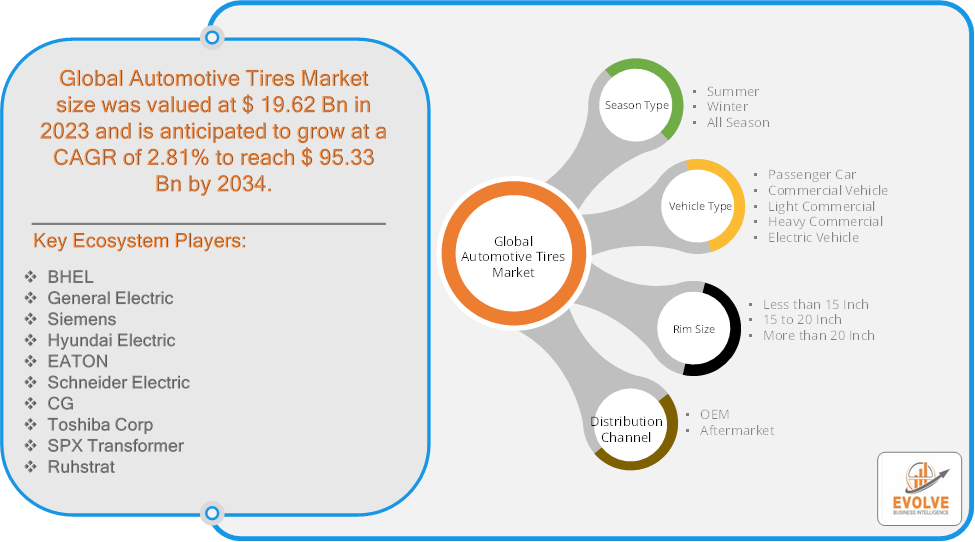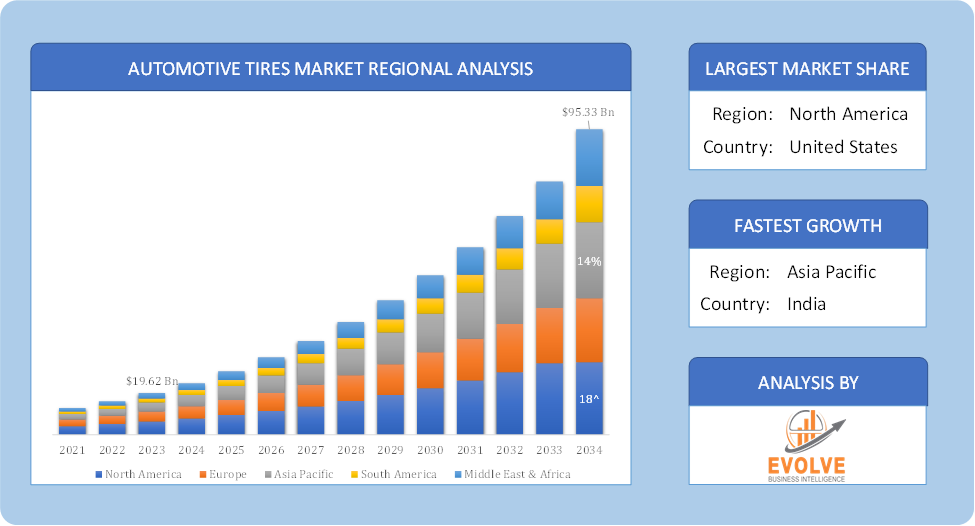Automotive Tires Market Analysis and Global Forecast 2021-2034
$ 1,390.00 – $ 5,520.00Price range: $ 1,390.00 through $ 5,520.00
Automotive Tires Market Research Report: By Season Type (Summer, Winter And All Season), By Vehicle Type (Passenger Car, Commercial Vehicle, Light Commercial, Heavy Commercial, And Electric Vehicle), By Rim Size (Less Than 15 Inch, 15 To 20 Inch, And More Than 20 Inch), By Distribution Channel (OEM and Aftermarket), and by Region — Forecast till 2034
Page: 162
Automotive Tires Market Overview
The Automotive Tires Market size accounted for USD 19.62 Billion in 2023 and is estimated to account for 20.25 Billion in 2024. The Market is expected to reach USD 95.33 Billion by 2034 growing at a compound annual growth rate (CAGR) of 2.81% from 2024 to 2034. An automotive tire is the circular vehicle component that is made of rubber and is used to cover the wheel’s rim externally. The main function of the tire is to protect the wheel rim and provide traction force between the road surface and the vehicle. As it is manufactured from rubber, it additionally provides a flexible cushion, hence lowering the impact of the vibrations and absorbs the shock of the vehicle. The rubber tire is made of thread, beads, jointless cap piles, and other materials such as fabric, synthetic rubber, and carbon black.
Global Automotive Tires Market Synopsis
 Global Automotive Tires Market Dynamics
Global Automotive Tires Market Dynamics
The major factors that have impacted the growth of Automotive Tires are as follows:
Drivers:
⮚ Technological Advancements in Tire Manufacturing
New development prospects in the tire industry are being generated by the ongoing developments in tire technology, such as run-flat tires, smart tires, and puncture-resistant tires. Tires are increasingly being fitted with sensors and digital technology to track wear, pressure, and performance in real time. Both consumers and automakers are placing more demand on these advances as they look to enhance performance and safety.
Restraint:
- High Capital Investment in Research and Development (R&D
Research and development expenditures must be increased significantly to meet the growing demand for sophisticated tires, such as run-flat, smart, or fuel-efficient tires. Manufacturers of tires under ongoing pressure to develop new products that enhance tire longevity, performance, and environmental effect. This requirement for ongoing innovation takes large resources, which can be a strain, particularly for smaller organizations. Additionally, producers take a risk when they spend in R&D because there is no assurance that their efforts will result in profitable products. Opportunity:
⮚ Growing Aftermarket Demand for Tire Replacements
For tire makers, the aftermarket sector, which includes tire replacement and maintenance services, offers a profitable opportunity. The need for tire replacements increases as cars get older and their tires get worn out. The world’s automobile fleet generates a continuous demand for aftermarket tires, particularly in areas where used car ownership is prevalent. Additionally, manufacturers have a lot of potential to capitalize on this replacement market due to the growing consumer knowledge of tire safety and maintenance as well as the growth of e-commerce platforms that sell tires.
Automotive Tires Market Segment Overview
Based on the Season Type, the market is segmented based on Summer, Winter And All Season. All Season segment dominates, as these tires offer versatility and convenience for consumers in regions with varying weather conditions, making them a popular choice among drivers.
By Vehicle Type
Based on Vehicle Type, the market has been divided into Passenger Car, Commercial Vehicle, Light Commercial, Heavy Commercial, And Electric Vehicle. Passenger Car segment dominates, driven by the high global demand for personal vehicles and the growing production of passenger cars in both developed and emerging markets.
By Rim Size
Based on the Rim Size, the market has been divided into Less Than 15 Inch, 15 To 20 Inch, And More Than 20 Inch. 15 to 20 inch rim size segment dominates, as this range is widely used in passenger vehicles, SUVs, and light trucks, which are popular across various regions.
By Distribution Channel
Based on Distribution Channel, the market has been divided into OEM and Aftermarket. Aftermarket segment dominates, driven by the constant demand for tire replacements and maintenance services as vehicles age, leading to frequent purchases from consumers and businesses.
Global Automotive Tires Market Regional Analysis
Based on region, the market has been divided into North America, Europe, Asia-Pacific, the Middle East & Africa, and Latin America. The area of Asia-Pacific is anticipated to dominate the market for the usage of Automotive Tires, followed by those in North America and Europe.
 Global Automotive Tires Asia Pacific Market
Global Automotive Tires Asia Pacific Market
The Asia Pacific region holds a dominant position in the Automotive Tires market Asia Pacific dominates the global automotive tire market owing to the presence of leading tire manufacturers in the region, such as BMW AG and Volkswagen Group. In addition to this, factors such as low cost of production, government initiatives for FDIs, and lenient emission & safety norms have increased the investment in the Asia Pacific region. Furthermore, Asia- Oceania has some of the biggest tire manufacturers such as Hankook Tires, Bridgestone Corporation, and many more in the region. Europe is estimated to grow at a high CAGR due to increasing demand from the major markets of the European Union.
Global Automotive Tires North America Market
The North America region is witnessing rapid growth and emerging as a significant market for the Automotive Tires industry. The North America Automotive Tires Market is characterized by a solid demand driven by the high vehicle ownership rate and the presence of established tire manufacturers. The market is further stimulated by the region’s emphasis on performance requirements and safety laws, especially for premium and high-performance tires. Specialized tire development is also being facilitated by the increasing trend of electric vehicle use.
Competitive Landscape
The competitive landscape includes key players (tier 1, tier 2, and local) having a presence across the globe. Companies such as Bridgestone Corporation, Continental, Michelin, Pirelli Tyre C., and The Goodyear Tire & Rubber Company are some of the leading players in the global Automotive Tires Industry. These players have adopted partnership, acquisition, expansion, and new product development, among others as their key strategies.
Key Market Players:
- Bridgestone Corporation
- Continental
- Michelin
- Pirelli Tyre C.
- The Goodyear Tire & Rubber Company
- Toyo Tire Corporation
- Sumitomo Rubber Industries Ltd
- The Yokohama Rubber Co. Ltd
- Hankook Tire & Technology Co. Ltd.
- Nokian Tyres
Key Development:
August 9, 2023: Continental reported robust earnings in the Tires group sector and a high order intake of around €8.6 billion in the Automotive sector at the end of the second quarter of 2023. While the Automotive group’s earnings fell short of projections mostly because of currency effects and ongoing extra freight expenses, the ContiTech group sector produced strong results. In addition, the second quarter’s inflation-related price talks are still going on. Continental has modified its forecast for sales in the Tires group sector and for consolidated sales due to changed market expectations in the tire replacement industry. The adjusted EBIT margin expectation is still unchanged.
Scope of the Report
Global Automotive Tires Market, by Season Type
- Summer
- Winter
- All Season
Global Automotive Tires Market, by Vehicle Type
- Passenger Car
- Commercial Vehicle
- Light Commercial
- Heavy Commercial
- Electric Vehicle
Global Automotive Tires Market, by Rim Size
- Less than 15 Inch
- 15 to 20 Inch
- More than 20 Inch
Global Automotive Tires Market, by Distribution Channel
- OEM
- Aftermarket
Global Automotive Tires Market, by Region
- North America
- US
- Canada
- Mexico
- Europe
- UK
- Germany
- France
- Italy
- Spain
- Benelux
- Nordic
- Rest of Europe
- Asia Pacific
- China
- Japan
- South Korea
- Indonesia
- Austalia
- Malaysia
- India
- Rest of Asia Pacific
- South America
- Brazil
- Argentina
- Rest of South America
- Middle East & Africa
- Saudi Arabia
- UAE
- Egypt
- South Africa
- Rest of Middle East & Africa
| Parameters | Indicators |
|---|---|
| Market Size | 2034: USD 95.33 Billion |
| CAGR (2021-2034) | 2.81% |
| Base year | 2023 |
| Forecast Period | 2021-2034 |
| Historical Data | 2021 (2017 to 2020 On Demand) |
| Report Coverage | Revenue Forecast, Competitive Landscape, Growth Factors, and Trends |
| Key Segmentations | Season Type, Vehicle Type, Rim Size, Distribution Channel |
| Geographies Covered | North America, Europe, Asia-Pacific, South America, Middle East, Africa. |
| Key Vendors | Bridgestone Corporation, Continental, Michelin, Pirelli Tyre C., The Goodyear Tire & Rubber Company, Toyo Tire Corporation, Sumitomo Rubber Industries Ltd, The Yokohama Rubber Co. Ltd, Hankook Tire & Technology Co. Ltd., Nokian Tyres |
| Key Market Opportunities | Governments are continually updating standards. Regulations concerning passenger safety. |
| Key Market Drivers | Increased vehicle production drives sales. |
REPORT CONTENT BRIEF:
- High-level analysis of the current and future Automotive Tires market trends and opportunities
- Detailed analysis of current market drivers, restraining factors, and opportunities in the future
- Automotive Tires market historical market size for the year 2022, and forecast from 2021 to 2034
- Automotive Tires market share analysis at each product level
- Competitor analysis with detailed insight into its product segment, Government & Defense strength, and strategies adopted.
- Identifies key strategies adopted including product launches and developments, mergers and acquisitions, joint ventures, collaborations, and partnerships as well as funding taken and investment done, among others.
- To identify and understand the various factors involved in the global Automotive Tires market affected by the pandemic
- To provide a detailed insight into the major companies operating in the market. The profiling will include the Government & Defense health of the company’s past 2-3 years with segmental and regional revenue breakup, product offering, recent developments, SWOT analysis, and key strategies.
Press Release

Global Pharmaceutical Manufacturing Market to Reach $1.38 Trillion by 2035 with 7.35% CAGR, New Research Shows

The Global Mammography Market Is Estimated To Record a CAGR of Around 10.29% During The Forecast Period

Glue Stick Market to Reach USD 2.35 Billion by 2034

Podiatry Service Market to Reach USD 11.88 Billion by 2034

Microfluidics Technology Market to Reach USD 32.58 Billion by 2034

Ferric Chloride Market to Reach USD 10.65 Billion by 2034

Family Practice EMR Software Market to Reach USD 21.52 Billion by 2034

Electric Hairbrush Market to Reach USD 15.95 Billion by 2034

Daily Bamboo Products Market to Reach USD 143.52 Billion by 2034

Cross-border E-commerce Logistics Market to Reach USD 112.65 Billion by 2034
Table of Content
Chapter 1. Executive Summary Chapter 2. Scope Of The Study 2.1. Market Definition 2.2. Scope Of The Study 2.2.1. Objectives of Report 2.2.2. Limitations 2.3. Market Structure Chapter 3. Evolve BI Methodology Chapter 4. Market Insights and Trends 4.1. Supply/ Value Chain Analysis 4.1.1. Raw Material Providers 4.1.2. Manufacturing Process 4.1.3. Distributors/Retailers 4.1.4. End Users 4.2. Porter’s Five Forces Analysis 4.2.1. Threat Of New Entrants 4.2.2. Bargaining Power Of Buyers 4.2.3. Bargaining Power Of Suppliers 4.2.4. Threat Of Substitutes 4.2.5. Industry Rivalry 4.3. Impact Of COVID-19 on Automotive Tires Market 4.3.1. Impact on Market Size 4.3.2. End User Trend, Preferences and Budget Impact 4.3.3. Regulatory Framework/Government Policies 4.3.4. Key Players Strategy to Tackle Negative Impact 4.3.5. Opportunity Window 4.4. Technology Overview 4.5. Macro factor 4.6. Micro Factor 4.7. Demand Supply Gap Analysis of Automotive Tires Market 4.8. Import Analysis of Automotive Tires Market 4.9. Export Analysis of Automotive Tires Market Chapter 5. Market Dynamics 5.1. Introduction 5.2. DROC Analysis 5.2.1. Drivers 5.2.2. Restraints 5.2.3. Opportunities 5.2.4. Challenges 5.3. Patent Analysis 5.4. Industry Roadmap 5.5. Parent/Peer Market Analysis Chapter 6. Global Automotive Tire Market, By Season Type 6.1. Introduction 6.2. Summer 6.3. Winter 6.4. All Season Chapter 7. Global Automotive Tire Market, By Vehicle Type 7.1. Introduction 7.2. Passenger Car 7.3. Commercial Vehicle 7.4. Light Commercial 7.5. Heavy Commercial 7.6. Electric Vehicle Chapter 8. Global Automotive Tire Market, By Rim Size 8.1. Introduction 8.2. Less than 15 Inch 8.3. 15 to 20 Inch 8.4. More than 20 Inch Chapter 9. Global Automotive Tire Market, By Distribution Channel 9.1. Introduction 9.2. OEM 9.3. Aftermarket Chapter 10. Global Automotive Tire Market, By Region 10.1. Introduction 10.2. North America 10.2.1. Introduction 10.2.2. Driving Factors, Opportunity Analyzed and Key Trends 10.2.3. Market Size and Forecast, By Country, 2020 - 2028 10.2.4. Market Size and Forecast, By Season Type, 2020 - 2028 10.2.5. Market Size and Forecast, By Vehicle Type, 2020 - 2028 10.2.6. Market Size and Forecast, By Rim Size, 2020 – 2028 10.2.7. Market Size and Forecast, By Distribution Channel, 2020 – 2028 10.2.8. US 10.2.8.1. Introduction 10.2.8.2. Driving Factors, Opportunity Analyzed and Key Trends 10.2.8.3. Market Size and Forecast, By Season Type, 2020 - 2028 10.2.8.4. Market Size and Forecast, By Vehicle Type, 2020 - 2028 10.2.8.5. Market Size and Forecast, By Rim Size, 2020 – 2028 10.2.8.6. Market Size and Forecast, By Distribution Channel, 2020 - 2028 10.2.9. Canada 10.2.9.1. Introduction 10.2.9.2. Driving Factors, Opportunity Analyzed and Key Trends 10.2.9.3. Market Size and Forecast, By Season Type, 2020 - 2028 10.2.9.4. Market Size and Forecast, By Vehicle Type, 2020 - 2028 10.2.9.5. Market Size and Forecast, By Rim Size, 2020 – 2028 10.2.9.6. Market Size and Forecast, By Distribution Channel, 2020 - 2028 10.3. Europe 10.3.1. Introduction 10.3.2. Driving Factors, Opportunity Analyzed and Key Trends 10.3.3. Market Size and Forecast, By Country, 2020 - 2028 10.3.4. Market Size and Forecast, By Season Type, 2020 - 2028 10.3.5. Market Size and Forecast, By Vehicle Type, 2020 - 2028 10.3.6. Market Size and Forecast, By Rim Size, 2020 – 2028 10.3.7. Market Size and Forecast, By Distribution Channel, 2020 – 2028 10.3.8. Germany 10.3.8.1. Introduction 10.3.8.2. Driving Factors, Opportunity Analyzed and Key Trends 10.3.8.3. Market Size and Forecast, By Season Type, 2020 - 2028 10.3.8.4. Market Size and Forecast, By Vehicle Type, 2020 - 2028 10.3.8.5. Market Size and Forecast, By Rim Size, 2020 – 2028 10.3.8.6. Market Size and Forecast, By Distribution Channel, 2020 - 2028 10.3.9. France 10.3.9.1. Introduction 10.3.9.2. Driving Factors, Opportunity Analyzed and Key Trends 10.3.9.3. Market Size and Forecast, By Season Type, 2020 - 2028 10.3.9.4. Market Size and Forecast, By Vehicle Type, 2020 - 2028 10.3.9.5. Market Size and Forecast, By Rim Size, 2020 – 2028 10.3.9.6. Market Size and Forecast, By Distribution Channel, 2020 - 2028 10.3.10. UK 10.3.10.1. Introduction 10.3.10.2. Driving Factors, Opportunity Analyzed and Key Trends 10.3.10.3. Market Size and Forecast, By Season Type, 2020 - 2028 10.3.10.4. Market Size and Forecast, By Vehicle Type, 2020 - 2028 10.3.10.5. Market Size and Forecast, By Rim Size, 2020 – 2028 10.3.10.6. Market Size and Forecast, By Distribution Channel, 2020 - 2028 10.3.11. Italy 10.3.11.1. Introduction 10.3.11.2. Driving Factors, Opportunity Analyzed and Key Trends 10.3.11.3. Market Size and Forecast, By Season Type, 2020 - 2028 10.3.11.4. Market Size and Forecast, By Vehicle Type, 2020 - 2028 10.3.11.5. Market Size and Forecast, By Rim Size, 2020 – 2028 10.3.11.6. Market Size and Forecast, By Distribution Channel, 2020 - 2028 10.3.12. Rest Of Europe 10.3.12.1. Introduction 10.3.12.2. Driving Factors, Opportunity Analyzed and Key Trends 10.3.12.3. Market Size and Forecast, By Season Type, 2020 - 2028 10.3.12.4. Market Size and Forecast, By Vehicle Type, 2020 - 2028 10.3.12.5. Market Size and Forecast, By Rim Size, 2020 – 2028 10.3.12.6. Market Size and Forecast, By Distribution Channel, 2020 - 2028 10.4. Asia-Pacific 10.4.1. Introduction 10.4.2. Driving Factors, Opportunity Analyzed and Key Trends 10.4.3. Market Size and Forecast, By Country, 2020 - 2028 10.4.4. Market Size and Forecast, By Season Type, 2020 - 2028 10.4.5. Market Size and Forecast, By Vehicle Type, 2020 - 2028 10.4.6. Market Size and Forecast, By Rim Size, 2020 – 2028 10.4.7. Market Size and Forecast, By Distribution Channel, 2020 - 2028 10.4.8. China 10.4.8.1. Introduction 10.4.8.2. Driving Factors, Opportunity Analyzed and Key Trends 10.4.8.3. Market Size and Forecast, By Season Type, 2020 - 2028 10.4.8.4. Market Size and Forecast, By Vehicle Type, 2020 - 2028 10.4.8.5. Market Size and Forecast, By Rim Size, 2020 – 2028 10.4.8.6. Market Size and Forecast, By Distribution Channel, 2020 - 2028 10.4.9. India 10.4.9.1. Introduction 10.4.9.2. Driving Factors, Opportunity Analyzed and Key Trends 10.4.9.3. Market Size and Forecast, By Season Type, 2020 - 2028 10.4.9.4. Market Size and Forecast, By Vehicle Type, 2020 - 2028 10.4.9.5. Market Size and Forecast, By Rim Size, 2020 – 2028 10.4.9.6. Market Size and Forecast, By Distribution Channel, 2020 - 2028 10.4.10. Japan 10.4.10.1. Introduction 10.4.10.2. Driving Factors, Opportunity Analyzed and Key Trends 10.4.10.3. Market Size and Forecast, By Season Type, 2020 - 2028 10.4.10.4. Market Size and Forecast, By Vehicle Type, 2020 - 2028 10.4.10.5. Market Size and Forecast, By Rim Size, 2020 – 2028 10.4.10.6. Market Size and Forecast, By Distribution Channel, 2020 - 2028 10.4.11. South Korea 10.4.11.1. Introduction 10.4.11.2. Driving Factors, Opportunity Analyzed and Key Trends 10.4.11.3. Market Size and Forecast, By Season Type, 2020 - 2028 10.4.11.4. Market Size and Forecast, By Vehicle Type, 2020 - 2028 10.4.11.5. Market Size and Forecast, By Rim Size, 2020 – 2028 10.4.11.6. Market Size and Forecast, By Distribution Channel, 2020 - 2028 10.4.12. Rest Of Asia-Pacific 10.4.12.1. Introduction 10.4.12.2. Driving Factors, Opportunity Analyzed and Key Trends 10.4.12.3. Market Size and Forecast, By Season Type, 2020 - 2028 10.4.12.4. Market Size and Forecast, By Vehicle Type, 2020 - 2028 10.4.12.5. Market Size and Forecast, By Rim Size, 2020 – 2028 10.4.12.6. Market Size and Forecast, By Distribution Channel, 2020 - 2028 10.5. Rest Of The World (RoW) 10.5.1. Introduction 10.5.2. Driving Factors, Opportunity Analyzed and Key Trends 10.5.3. Market Size and Forecast, By Season Type, 2020 - 2028 10.5.4. Market Size and Forecast, By Vehicle Type, 2020 - 2028 10.5.5. Market Size and Forecast, By Rim Size, 2020 – 2028 10.5.6. Market Size and Forecast, By Distribution Channel, 2020 - 2028 Chapter 11. Company Landscape 11.1. Introduction 11.2. Vendor Share Analysis 11.3. Key Development Analysis 11.4. Competitor Dashboard Chapter 12. Company Profiles 12.1. Bridgestone Corporation 12.1.1. Business Overview 12.1.2. Financial Analysis 12.1.2.1. Financial – Existing/Funding 12.1.3. Product Portfolio 12.1.4. Recent Development and Strategies Adopted 12.1.5. SWOT Analysis 12.2. Continental AG 12.2.1. Business Overview 12.2.2. Financial Analysis 12.2.2.1. Financial – Existing/Funding 12.2.3. Product Portfolio 12.2.4. Recent Development and Strategies Adopted 12.2.5. SWOT Analysis 12.3. Michelin 12.3.1. Business Overview 12.3.2. Financial Analysis 12.3.2.1. Financial – Existing/Funding 12.3.3. Product Portfolio 12.3.4. Recent Development and Strategies Adopted 12.3.5. SWOT Analysis 12.4. Pirelli Tyre C. S.p.A 12.4.1. Business Overview 12.4.2. Financial Analysis 12.4.2.1. Financial – Existing/Funding 12.4.3. Product Portfolio 12.4.4. Recent Development and Strategies Adopted 12.4.5. SWOT Analysis 12.5. The Goodyear Tire & Rubber Company 12.5.1. Business Overview 12.5.2. Financial Analysis 12.5.2.1. Financial – Existing/Funding 12.5.3. Product Portfolio 12.5.4. Recent Development and Strategies Adopted 12.5.5. SWOT Analysis 12.6. Toyo Tire Corporation 12.6.1. Business Overview 12.6.2. Financial Analysis 12.6.2.1. Financial – Existing/Funding 12.6.3. Product Portfolio 12.6.4. Recent Development and Strategies Adopted 12.6.5. SWOT Analysis 12.7. Sumitomo Rubber Industries Ltd 12.7.1. Business Overview 12.7.2. Financial Analysis 12.7.2.1. Financial – Existing/Funding 12.7.3. Product Portfolio 12.7.4. Recent Development and Strategies Adopted 12.7.5. SWOT Analysis 12.8. The Yokohama Rubber Co. Ltd 12.8.1. Business Overview 12.8.2. Financial Analysis 12.8.2.1. Financial – Existing/Funding 12.8.3. Product Portfolio 12.8.4. Recent Development and Strategies Adopted 12.8.5. SWOT Analysis 12.9. Hankook Tire & Technology Co. Ltd 12.9.1. Business Overview 12.9.2. Financial Analysis 12.9.2.1. Financial – Existing/Funding 12.9.3. Product Portfolio 12.9.4. Recent Development and Strategies Adopted 12.9.5. SWOT Analysis 12.10. Nokian Tyres plc 12.10.1. Business Overview 12.10.2. Financial Analysis 12.10.2.1. Financial – Existing/Funding 12.10.3. Product Portfolio 12.10.4. Recent Development and Strategies Adopted 12.10.5. SWOT Analysis Chapter 13. Key Takeaways
Connect to Analyst
Research Methodology









